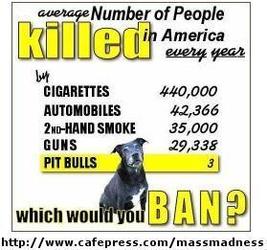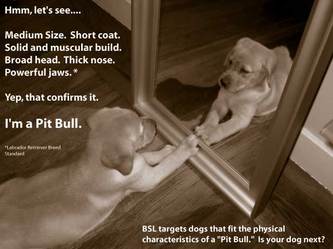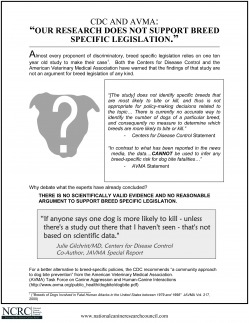The ins and outs of Breed Specific Legislation
Maybe you've heard, and maybe you haven;t, but some cities, states, and even countries have been banning specific breeds of dogs. It's not exactly new, there are some bans that started in the 80's.
So, what exactly does a breed ban entail? In some areas, there are specific ways in which a banned breed must be handled. It might include liability insurance on the dog, muzzling in public, specific housing standards, special licensing fees, mandatory neutering, and even regulations on the length of leash. In other areas, there are absolutely NO dogs of the banned breeds allowed, with a death sentence on any found. Sometimes, the owner of the banned dog is given time to get rid of it; other times, their dog is seized and usually put to sleep.
So... you may still be wondering what the big deal is. Well, there are several issues that many people fine with this type of legislation.
1. How do you KNOW a dog in question is of a banned breed? Well, unless the dog is registered, there can be a lot of wiggle room in the phrasing of many of the bills. For instance, many say the dogs which are banned include American Pit Bull Terriers, American Staffordshire Terriers, or any dog that is similar in charachteristics to either of these breeds. Does it sound cut and dry? It leaves the decision up to people who may not know the breed well, and may not come to the correct conclusion. And let's not even start on the mixed breeds! here's a link to a page of dogs that may on the outside appear to be pit bull mixes, but in truth are not! http://nationalcanineresearchcouncil.com/wp-content/uploads/2009/03/find-a-bull1.pdf
2. BSL puts unneccesary emphasis on "Pit Bull" Attacks. What about little Jimmy who got mauled by his mom's lab? It hurt just as much, but just because the dog is not of a banned breed, he will recieve less attention, both from law enforcement and the media. And, innocent people continue to be threatened, bitten, traumatized, disfigured, and killed—by non-targeted breeds and types of dogs. Nobody learns anything about the real reasons why dogs bite and attack, safety around dogs, or responsible dog ownership.
3. IT DOESN'T WORK. There are a number of locations which have implemented the bans, and there is not one area which documaneted a decrease in dog bites after banning the breed.
-The Netherlands is looking into repealing their ban after the actual rise in dog bites.
-In the UK, all "dangerous" breeds were banned. Between 1997 and 2007, their instances of dog bites has INCREASED 50%!
-Spain passed the Dangerous Animals Act in 2000, placing restrictions on nine breeds of dogs. A scientific study analyzing dog bites reported to the Aragon health department during a five year period before the Act was passed (1995 to 1999) and the five year period after passage (2000 to 2004) found that there was no significant difference in the number of dog bites in Spain before or after the Dangerous Animals Act passed.
-In 1996, Prince George’s County, Maryland, instituted a pit bull ban. In 2003, a task force set out to determine whether the ban was having the desired effect in a number of areas, including public safety. The task force expressed concern that the ban might actually be having a negative effect on public safety; animal control facilities and workers were stretched thin because they were constantly having to respond to “pit bull” complaints and house alleged pit bulls. The task force felt that this had a negative effect on animal control’s ability to respond to other types of violations. There was no positive impact resulting from the breed ban.
-Denver, CO's ban on “pit bulls” has been in place since 1989, and has long been touted as a success by a handful of Denver officials, but it turns out that the results of the ban have been unclear. Since the ban, there has been no fatal attack by a pit bull, but there has been a fatal attack by a chow mix. There have een fewer bites from pit bulls, but bites from ALL breeds have declined. Bites from other types of dogs now exceed those by pit bulls. Recent Press coverage has also noted: “Between 1995 and 2006, Denver had almost six times as many dog-related hospitalizations compared to Boulder, even though Denver’s population is less than twice that of Boulder.” Boulder does not have BSL.
4. Millions of dollars are wasted and animal control resources stretched thin in order to kill dogs and not save people.
5. Abusive and irresponsible owners carry on with “business as usual," while good owners and their families are outcasts (if they keep their targeted dog) or devastated (if they give up their targeted dog)
Here's an artilce in pdf. which, with the simple title "BREED SPECIFIC or LOOKS SPECIFIC," brings to the forefront the biggest issue with BSL. Click on the picture below to read it.
So, what exactly does a breed ban entail? In some areas, there are specific ways in which a banned breed must be handled. It might include liability insurance on the dog, muzzling in public, specific housing standards, special licensing fees, mandatory neutering, and even regulations on the length of leash. In other areas, there are absolutely NO dogs of the banned breeds allowed, with a death sentence on any found. Sometimes, the owner of the banned dog is given time to get rid of it; other times, their dog is seized and usually put to sleep.
So... you may still be wondering what the big deal is. Well, there are several issues that many people fine with this type of legislation.
1. How do you KNOW a dog in question is of a banned breed? Well, unless the dog is registered, there can be a lot of wiggle room in the phrasing of many of the bills. For instance, many say the dogs which are banned include American Pit Bull Terriers, American Staffordshire Terriers, or any dog that is similar in charachteristics to either of these breeds. Does it sound cut and dry? It leaves the decision up to people who may not know the breed well, and may not come to the correct conclusion. And let's not even start on the mixed breeds! here's a link to a page of dogs that may on the outside appear to be pit bull mixes, but in truth are not! http://nationalcanineresearchcouncil.com/wp-content/uploads/2009/03/find-a-bull1.pdf
2. BSL puts unneccesary emphasis on "Pit Bull" Attacks. What about little Jimmy who got mauled by his mom's lab? It hurt just as much, but just because the dog is not of a banned breed, he will recieve less attention, both from law enforcement and the media. And, innocent people continue to be threatened, bitten, traumatized, disfigured, and killed—by non-targeted breeds and types of dogs. Nobody learns anything about the real reasons why dogs bite and attack, safety around dogs, or responsible dog ownership.
3. IT DOESN'T WORK. There are a number of locations which have implemented the bans, and there is not one area which documaneted a decrease in dog bites after banning the breed.
-The Netherlands is looking into repealing their ban after the actual rise in dog bites.
-In the UK, all "dangerous" breeds were banned. Between 1997 and 2007, their instances of dog bites has INCREASED 50%!
-Spain passed the Dangerous Animals Act in 2000, placing restrictions on nine breeds of dogs. A scientific study analyzing dog bites reported to the Aragon health department during a five year period before the Act was passed (1995 to 1999) and the five year period after passage (2000 to 2004) found that there was no significant difference in the number of dog bites in Spain before or after the Dangerous Animals Act passed.
-In 1996, Prince George’s County, Maryland, instituted a pit bull ban. In 2003, a task force set out to determine whether the ban was having the desired effect in a number of areas, including public safety. The task force expressed concern that the ban might actually be having a negative effect on public safety; animal control facilities and workers were stretched thin because they were constantly having to respond to “pit bull” complaints and house alleged pit bulls. The task force felt that this had a negative effect on animal control’s ability to respond to other types of violations. There was no positive impact resulting from the breed ban.
-Denver, CO's ban on “pit bulls” has been in place since 1989, and has long been touted as a success by a handful of Denver officials, but it turns out that the results of the ban have been unclear. Since the ban, there has been no fatal attack by a pit bull, but there has been a fatal attack by a chow mix. There have een fewer bites from pit bulls, but bites from ALL breeds have declined. Bites from other types of dogs now exceed those by pit bulls. Recent Press coverage has also noted: “Between 1995 and 2006, Denver had almost six times as many dog-related hospitalizations compared to Boulder, even though Denver’s population is less than twice that of Boulder.” Boulder does not have BSL.
4. Millions of dollars are wasted and animal control resources stretched thin in order to kill dogs and not save people.
5. Abusive and irresponsible owners carry on with “business as usual," while good owners and their families are outcasts (if they keep their targeted dog) or devastated (if they give up their targeted dog)
Here's an artilce in pdf. which, with the simple title "BREED SPECIFIC or LOOKS SPECIFIC," brings to the forefront the biggest issue with BSL. Click on the picture below to read it.






